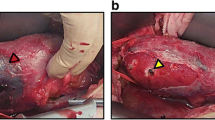Abstract
A 42-year-old Syrian citizen was admitted to the internal department from the intensive care unit after war injury. Laparotomy and splenectomy had been undertaken in another hospital few days before admission to our hospital.
On admission to the hospital, he was fully conscious, pale, and dyspneic; a deep wound on his buttock and a surgical suture with serous discharge were noted on his left upper abdomen.
Laboratory examination reveals creatinine 10 mg% and hemoglobin 8 g%, and metabolic acidosis was noted on arterial blood gases.
He was treated with massive blood and fluid resuscitation and hemodialysis with gradual amelioration.
Acute tubular necrosis secondary to blood loss and nephrotoxic antibiotic drug treatment was assumed as the main mechanism to explain his acute renal failure.
Access this chapter
Tax calculation will be finalised at checkout
Purchases are for personal use only
Similar content being viewed by others
References
Nash K, Hafeez A, Hou S. Hospital-acquired renal insufficiency. Am J Kidney Dis. 2002;39:930.
Bagshaw SM, Bellomo R, Kellum JA. Oliguria, volume overload, and loop diuretics. Crit Care Med. 2008;36:S172.
Grams ME, Estrella MM, Coresh J, et al. Fluid balance, diuretic use, and mortality in acute kidney injury. Clin J Am Soc Nephrol. 2011;6:966.
Goldstein SL, Somers MJ, Baum MA, et al. Pediatric patients with multi-organ dysfunction syndrome receiving continuous renal replacement therapy. Kidney Int. 2005;67:653.
Payen D, de Pont AC, Sakr Y, et al. A positive fluid balance is associated with a worse outcome in patients with acute renal failure. Crit Care. 2008;12:R74.
Bouchard J, Soroko SB, Chertow GM, et al. Fluid accumulation, survival and recovery of kidney function in critically ill patients with acute kidney injury. Kidney Int. 2009;76:422.
Kraut JA, Kurtz I. Use of base in the treatment of severe acidemic states. Am J Kidney Dis. 2001;38:703.
Marsh JD, Margolis TI, Kim D. Mechanism of diminished contractile response to catecholamines during acidosis. Am J Physiol. 1988;254:H20.
Mitchell JH, Wildenthal K, Johnson Jr RL. The effects of acid-base disturbances on cardiovascular and pulmonary function. Kidney Int. 1972;1:375.
Teplinsky K, O'Toole M, Olman M, et al. Effect of lactic acidosis on canine hemodynamics and left ventricular function. Am J Physiol. 1990;258:H1193.
Orchard CH, Kentish JC. Effects of changes of pH on the contractile function of cardiac muscle. Am J Physiol. 1990;258:C967.
Mathieu D, Neviere R, Billard V, et al. Effects of bicarbonate therapy on hemodynamics and tissue oxygenation in patients with lactic acidosis: a prospective, controlled clinical study. Crit Care Med. 1991;19:1352.
Orchard CH, Cingolani HE. Acidosis and arrhythmias in cardiac muscle. Cardiovasc Res. 1994;28:1312.
Kraut JA, Madias NE. Treatment of acute metabolic acidosis: a pathophysiologic approach. Nat Rev Nephrol. 2012;8:589.
Heparin ML, Goldstein MB. Metabolic acidosis. In:Fluid, electrolyte and acid-base physiology. Philadelphia: WB Saunders; 1993.
Dellinger RP, Levy MM, Carlet JM, et al. Surviving sepsis campaign: international guidelines for management of severe sepsis and septic shock: 2008. Crit Care Med. 2008;36:296.
Cooper DJ, Walley KR, Wiggs BR, Russell JA. Bicarbonate does not improve hemodynamics in critically ill patients who have lactic acidosis. A prospective, controlled clinical study. Ann Intern Med. 1990;112:492.
Glaser N, Barnett P, McCaslin I, et al. Risk factors for cerebral edema in children with diabetic ketoacidosis. The Pediatric Emergency Medicine Collaborative Research Committee of the American Academy of Pediatrics. N Engl J Med. 2001;344:264.
Massry SG, Stein R, Garty J, et al. Skeletal resistance to the calcemic action of parathyroid hormone in uremia: role of 1,25 (OH)2 D3. Kidney Int. 1976;9:467.
Massry SG, Arieff AI, Coburn JW, et al. Divalent ion metabolism in patients with acute renal failure: studies on the mechanism of hypocalcemia. Kidney Int. 1974;5:437.
Tohme JF, Bilezikian JP. Diagnosis and treatment of hypocalcemic emergencies. Endocrinologist. 1996;6:10.
Fiaccadori E, Cremaschi E. Nutritional assessment and support in acute kidney injury. Curr Opin Crit Care. 2009;15:474.
Krishnan JA, Parce PB, Martinez A, et al. Caloric intake in medical ICU patients: consistency of care with guidelines and relationship to clinical outcomes. Chest. 2003;124:297.
Bellomo R, Seacombe J, Daskalakis M, et al. A prospective comparative study of moderate versus high protein intake for critically ill patients with acute renal failure. Ren Fail. 1997;19:111.
Fouque D, Kalantar-Zadeh K, Kopple J, et al. A proposed nomenclature and diagnostic criteria for protein-energy wasting in acute and chronic kidney disease. Kidney Int. 2008;73:391.
McClave SA, Martindale RG, Vanek VW, et al. Guidelines for the provision and assessment of nutrition support therapy in the adult critically ill patient: Society of Critical Care Medicine (SCCM) and American Society for Parenteral and Enteral Nutrition (A.S.P.E.N.). J Parenter Enteral Nutr. 2009;33:277.
Fiaccadori E, Maggiore U, Giacosa R, et al. Enteral nutrition in patients with acute renal failure. Kidney Int. 2004;65:999.
Li Y, Tang X, Zhang J, Wu T. Nutritional support for acute kidney injury. Cochrane Database Syst Rev 2010:CD005426.
Lameire N, Van Biesen W, Vanholder R. Acute renal failure. Lancet. 2005;365:417.
Author information
Authors and Affiliations
Corresponding author
Editor information
Editors and Affiliations
Rights and permissions
Copyright information
© 2017 Springer International Publishing AG
About this chapter
Cite this chapter
Farah, R., Ben-Dror, G. (2017). Reversible War-Induced Renal Failure. In: Zarka, S., Lerner, A. (eds) Complicated War Trauma and Care of the Wounded . Springer, Cham. https://doi.org/10.1007/978-3-319-53339-1_23
Download citation
DOI: https://doi.org/10.1007/978-3-319-53339-1_23
Published:
Publisher Name: Springer, Cham
Print ISBN: 978-3-319-53338-4
Online ISBN: 978-3-319-53339-1
eBook Packages: MedicineMedicine (R0)




